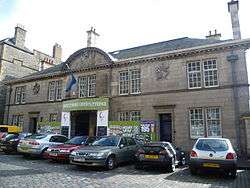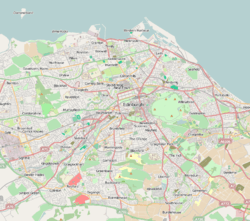Dalmeny Street drill hall
| Dalmeny Street drill hall | |
|---|---|
| Edinburgh, Scotland | |
 Dalmeny Street drill hall | |
 Dalmeny Street drill hall Location in Edinburgh | |
| Coordinates | 55°57′53″N 3°10′27″W / 55.9646°N 3.1742°WCoordinates: 55°57′53″N 3°10′27″W / 55.9646°N 3.1742°W |
| Type | Drill hall |
| Site history | |
| Built | 1901 |
| Built for | War Office |
| Architect | Sir Robert Rowand Anderson |
| In use | 1901 – 1999 |
The Dalmeny Street drill hall in Edinburgh, was built as a military drill hall in 1901, and between 2003 and 2010 was redeveloped as community arts and education centre under the name The Out of the Blue Drill Hall. The drill hall is protected as a category B listed building.[1]
History
The drill hall was designed by Sir Robert Rowand Anderson as the headquarters of the 5th Volunteer Battalion Royal Scots (Lothian Regiment) and was completed in 1901.[1] This unit evolved to become the 7th (Leith) Battalion, The Royal Scots in 1908.[1] The battalion was mobilised at the drill hall in August 1914 before being deployed to Gallipoli.[2] In 1915 the Gretna disaster, the worst crash in the history of British rail travel, killed 227 people and injured 246 others. 102 of those killed were young men from the 7th (Leith) Battalion of the Royal Scots, on their way to Liverpool, where they were to leave for Gallipoli. The bodies of the victims were laid out in the drill hall prior to burial in Rosebank Cemetery, across Leith Walk in Pilrig. The drill hall is therefore connected to one of the greatest tragedies to affect the community of Leith.[1][3]
The battalion amalgamated with the 9th Battalion to become the 7th/9th (Highlanders) Battalion, The Royal Scots, with its headquarters at the Dalmeny Street drill hall, in 1922.[4] The drill hall was shared with 226 (City of Edinburgh) and 227 (Haddingtonshire) Medium Batteries (Howitzers) of the 57th (Lowland) Medium Brigade, Royal Artillery, which had been formed from the former 6th and 8th Battalions, Royal Scots.[5][6]
In 1938 the 7th/9th Battalion formed a nw 8th Battalion as its duplicate. The 7th/9th Battalion and the 8th Battalion amalgamated to form the 8th/9th Battalion in 1961 and the 8th/9th Battalion was reduced to company size as A (Royal Scots) Company of the 52nd Lowland Volunteers, still at the Dalmeny Street drill hall, in 1967.[4] This unit in turn evolved to become HQ (Royal Scots) Company, Lowland Volunteers, still at the Dalmeny Street drill hall, in 1995.[7]
After the unit moved to the East Claremont Street drill hall, as A (Royal Scots) Company, 52nd Lowland Regiment, in 1999,[7] the Dalmeny Street drill hall was decommissioned and sold to the arts charity Out of the Blue in 2003. The group, with the aid of City Architecture Office, transformed the drill hall into an arts and education centre. The centre, which was fully completed in 2010, incorporates a café, a gallery, artist studios, rehearsal rooms and performance spaces.[8]
References
- 1 2 3 4 "Territorial Army Drill Hall: Listed Building Report". Historic Scotland. Retrieved 30 September 2011.
- ↑ "The Royal Scots". The Long, Long Trail. Retrieved 21 May 2017.
- ↑ "Commemorating the Gretna rail disaster: OOTB Arts & Education Trust". www.outoftheblue.org.uk. Retrieved 2018-02-05.
- 1 2 "The Territorial Army". Royal Scots. Retrieved 11 June 2017.
- ↑ Army List.
- ↑ Norman E.H. Litchfield, The Territorial Artillery 1908–1988 (Their Lineage, Uniforms and Badges), Nottingham: Sherwood Press, 1992, ISBN 0-9508205-2-0, pp. 295–8.
- 1 2 "Lowland Volunteers". British Army units 1945 on. Retrieved 11 June 2017.
- ↑ "The Drill Hall, Leith, Edinburgh : Information + Images". edinburgharchitecture. June 2010.